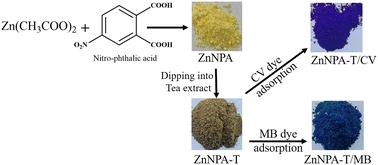当前位置:
X-MOL 学术
›
CrystEngComm
›
论文详情
Our official English website, www.x-mol.net, welcomes your feedback! (Note: you will need to create a separate account there.)
Highly enhanced cationic dye adsorption from water by nitro-functionalized Zn-MOF nano/microparticles and a biomolecular binder for improving the reusability
CrystEngComm ( IF 3.1 ) Pub Date : 2024-04-01 , DOI: 10.1039/d4ce00131a Gunasekaran Arunkumar 1 , Mehboobali Pannipara 2, 3 , Abdullah G. Al-Sehemi 2, 3 , Savarimuthu Philip Anthony 1
CrystEngComm ( IF 3.1 ) Pub Date : 2024-04-01 , DOI: 10.1039/d4ce00131a Gunasekaran Arunkumar 1 , Mehboobali Pannipara 2, 3 , Abdullah G. Al-Sehemi 2, 3 , Savarimuthu Philip Anthony 1
Affiliation

|
Zinc metal–organic frameworks (Zn-MOFs) of phthalic acid (ZnPA) and nitro-phthalic acid (ZnNPA) microcrystalline particles were fabricated and utilized for the removal of organic cationic dyes (crystal violet (CV), methylene blue (MB) and rhodamine B (RhB)) from water. PXRD studies confirmed the formation of crystalline materials, and BET indicated the mesoporous structure. HR-SEM studies showed the rod and plate morphologies for ZnPA and ZnNPA, respectively. ZnPA revealed low adsorption of dyes (CV, 20%) whereas ZnNPA showed significantly enhanced dye adsorption (CV, 99%). In particular, ZnNPA exhibited higher adsorption of CV (99%) and MB dye (83%) compared to RhB (54%). Nevertheless, ZnNPA could not be reused due to strong adsorption of dyes. Hence, a natural binder was introduced by dipping ZnNPA into tea extract, which also showed high adsorption of CV and MB dyes. Kinetics of adsorption exhibited best fitting with the pseudo-second-order model, indicating strong interactions between the dyes and adsorbent. Adsorption isotherm fitting suggested a good correlation coefficient (R2) with the Freundlich model, suggesting multi-layer adsorption. Interestingly, ZnNPA showed high adsorption of CV and MB dyes across the pH range between 3.0 and 11.0. The binder-introduced ZnNPA adsorbent was easily regenerated and demonstrated three cycles of reusability without significant change in the dye adsorption. Thus, the present work indicated the role of functional groups in the ligand and binder for improving the dye adsorption characteristics of MOFs.
中文翻译:

硝基功能化 Zn-MOF 纳米/微粒和生物分子粘合剂高度增强对水中阳离子染料的吸附,以提高可重复使用性
制备了邻苯二甲酸(ZnPA)和硝基邻苯二甲酸(ZnNPA)的锌金属有机骨架(Zn-MOF)微晶颗粒,并用于去除有机阳离子染料(结晶紫(CV)、亚甲蓝(MB)和从水中提取罗丹明 B (RhB))。 PXRD 研究证实了晶体材料的形成,BET 表明了介孔结构。 HR-SEM 研究分别显示了 ZnPA 和 ZnNPA 的棒状和板状形态。 ZnPA 显示出较低的染料吸附(CV,20%),而 ZnNPA 显示出显着增强的染料吸附(CV,99%)。特别是,与 RhB (54%) 相比,ZnNPA 对 CV (99%) 和 MB 染料 (83%) 的吸附率更高。然而,由于ZnNPA对染料的强烈吸附作用,无法重复使用。因此,通过将 ZnNPA 浸入茶提取物中引入天然粘合剂,这也表现出对 CV 和 MB 染料的高吸附性。吸附动力学表现出与伪二阶模型的最佳拟合,表明染料和吸附剂之间存在很强的相互作用。吸附等温线拟合表明与Freundlich模型有良好的相关系数( R 2 ),表明存在多层吸附。有趣的是,ZnNPA 在 3.0 至 11.0 的 pH 范围内表现出对 CV 和 MB 染料的高吸附性。引入粘合剂的 ZnNPA 吸附剂很容易再生,并且表现出三个循环的可重复使用性,而染料吸附没有显着变化。因此,目前的工作表明了配体和粘合剂中官能团在改善 MOF 的染料吸附特性方面的作用。
更新日期:2024-04-01
中文翻译:

硝基功能化 Zn-MOF 纳米/微粒和生物分子粘合剂高度增强对水中阳离子染料的吸附,以提高可重复使用性
制备了邻苯二甲酸(ZnPA)和硝基邻苯二甲酸(ZnNPA)的锌金属有机骨架(Zn-MOF)微晶颗粒,并用于去除有机阳离子染料(结晶紫(CV)、亚甲蓝(MB)和从水中提取罗丹明 B (RhB))。 PXRD 研究证实了晶体材料的形成,BET 表明了介孔结构。 HR-SEM 研究分别显示了 ZnPA 和 ZnNPA 的棒状和板状形态。 ZnPA 显示出较低的染料吸附(CV,20%),而 ZnNPA 显示出显着增强的染料吸附(CV,99%)。特别是,与 RhB (54%) 相比,ZnNPA 对 CV (99%) 和 MB 染料 (83%) 的吸附率更高。然而,由于ZnNPA对染料的强烈吸附作用,无法重复使用。因此,通过将 ZnNPA 浸入茶提取物中引入天然粘合剂,这也表现出对 CV 和 MB 染料的高吸附性。吸附动力学表现出与伪二阶模型的最佳拟合,表明染料和吸附剂之间存在很强的相互作用。吸附等温线拟合表明与Freundlich模型有良好的相关系数( R 2 ),表明存在多层吸附。有趣的是,ZnNPA 在 3.0 至 11.0 的 pH 范围内表现出对 CV 和 MB 染料的高吸附性。引入粘合剂的 ZnNPA 吸附剂很容易再生,并且表现出三个循环的可重复使用性,而染料吸附没有显着变化。因此,目前的工作表明了配体和粘合剂中官能团在改善 MOF 的染料吸附特性方面的作用。



























 京公网安备 11010802027423号
京公网安备 11010802027423号